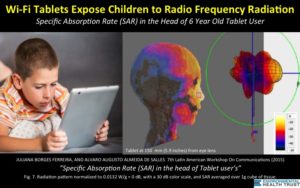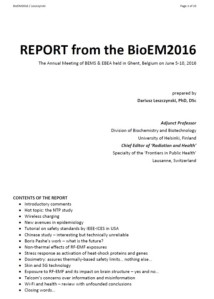BioEM2016 report + 15 new studies on electromagnetic fields and biology or health
Report on BioEM2016 Conference
A 23-page report about BioEM2016, the annual meeting of the Bioelectromagnetics Society and the European Bioelectromagnetics Association, prepared by Dr. Dariusz Leszczynski, is now available. A summary of Dr. Leszczynski's evaluative comments regarding key sessions at this conference and a link to the full report is available on my EMR Safety web site at http://bit.ly/bioem2016.
--
Comprehensive personal RF-EMF exposure map and its potential use in epidemiological studies
Jesus Gonzalez-Rubio, Alberto Najera, Enrique Arribas. Comprehensive personal RF-EMF exposure map and its potential use in epidemiological studies. doi:10.1016/j.envres.2016.05.010
Highlights
• Personal RF-EMF exposure was measured in the city of Albacete (Spain).
• A lattice map was prepared with the city's administrative regions.
• Spatial randomness of mobile phone antennas and personal exposition were analysed.
• Spearman correlation between antennas and intensities was studied.
Abstract
In recent years, numerous epidemiological studies, which deal with the potential effects of mobile phone antennas on health, have almost exclusively focused on their distance to mobile phone base stations. Although it is known that this is not the best approach to the problem, this situation occurs due to the numerous difficulties when determining the personal exposure to the radiofrequency electromagnetic fields (RF-EMF).
However, due to the rise of personal exposimeters, the evolution of spatial statistics, the development of geographical information systems and the use of powerful software, new alternatives are available to deal with these epidemiological studies and thus overcome the aforementioned difficulties. Using these tools, this paper presents a lattice map of personal RF-EMF exposure from exterior mobile phone base stations, covering the entire 110 administrative regions in the city of Albacete (Spain). For this purpose, we used a personal exposimeter, Satimo EME Spy 140 model, performing measurements every 4 s The exposimeter was located inside the plastic basket of a bicycle, whose versatility permitted the access to all the zones of the city.
Once the exposure map was prepared, its relation with the known antenna locations was studied. The 64 mobile telephone antennas of the city were also georeferenced; the randomness of both variables (exposure and antennas) were studied by means of the Moran's I test. Results showed that the distribution of the antennas follows a grouped pattern (p<0 .001="" a="" addition="" administrative="" also="" and="" antennas="" average="" between="" cases.="" considering="" correlation="" detected="" distribution="" either="" exposure="" first="" font="" have="" in="" mobile="" neighbouring="" no="" number="" of="" p="0.618)." per="" random="" region="" regions.="" second="" showed="" spearman="" studies:="" substantial="" telephone="" the="" two="" values="" was="" we="" while="">
This study also reveals the weaknesses of the epidemiological studies, which only take into account the distance to the antennas, which would provide a new approach to the problem. By precisely knowing the resident population of each administrative region of the city, this proves to be highly useful to rely on a prepared aggregate data map based on the mean exposure values to RF-EMF in these sections. The displayed map would permit the execution of more accurate epidemiological studies, since it would be possible to compare the exposure measurements with the incidence data of a disease.
--
Assessment of personal radio frequency electromagnetic field exposure in specific indoor workplaces and possible worst-case scenarios
Mimoza Ibrani , Enver Hamiti, , Luan Ahma , Besfort Shala. Assessment of personal radio frequency electromagnetic field exposure in specific indoor workplaces and possible worst-case scenarios. AEU - International Journal of Electronics and Communications. 70(6):808-813. Jun 2016. doi:10.1016/j.aeue.2016.03.007
Abstract
The aim of this study is to examine the electromagnetic field (ranging from 80 MHz to 6 GHz) exposure level at different locations over time in Prishtina, Kosovo, and develop possible worst-case exposure scenarios. We performed personal exposure measurement for persons working in the offices of some companies which are characterized by extensive use of wireless technologies. The measurements were recorded during working hours, after working hours and during the weekends. The results showed that the total mean power density value of the working day was 0.524 mW/m2. During the weekend, for the same exposure hours as working day, the mean power density value was 0.828 mW/m2. The total mean power density value has been just 0.676 mW/m2. Due to the usage of the DECT system, the total mean power density value of the work day was approximately 37% less when compared to the weekend. Based on the results obtained from our measurement campaign, we may conclude that the mean values of the power density for office environments in Kosovo are comparable with those of several European countries.
--
Mobile phone use and possible cancer risk: Current perspectives in India
Meena JK, Verma A, Kohli C, Ingle GK. Mobile phone use and possible cancer risk: Current perspectives in India. Indian J Occup Environ Med. 2016 Jan-Apr;20(1):5-9.
Abstract
Mobile communication is now essentially ruling our daily lives through better connectivity and intelligent smartphone services. There has been a tremendous growth in Indian communication industry along with growing concerns regarding health effects of mobile radiation exposure. Concerns posed are especially regarding carcinogenesis and other health-related effects of mobile radiation exposure. In the effort to establish or refute any such concerns, many studies have been undertaken in the past three decades, mostly case-control designs or cross-sectional surveys. However, most of them considerably failed to establish causal association primarily owing to potential biases and errors in their conduct and analysis. Past cohort studies have provided contradictory results leading to continued uncertainty regarding tumorigenic potential of mobile radiation exposure. In India, there remains a huge knowledge gap pertaining to this particular topic and only few studies are presently underway such as the Indian Council of Medical Research (ICMR) cell phone study in the National capital region (NCR). International Agency for Research on Cancer (IARC) has classified radiofrequency electromagnetic fields associated with wireless phone use as possibly carcinogenic to humans (Group 2B), causing major concerns worldwide among mobile companies and subscribers equivocally. The World Health Organization (WHO) is presently carrying formal risk assessment of all studied health outcomes from radio frequency field's exposures and is likely to publish it by the year 2016.
--
Brain Topography of EMF-Induced EEG-Changes in Restful Wakefulness: Tracing Current Effects, Targeting Future Prospects
Gjoneska B, Markovska-Simoska S, Hinrikus H, Pop-Jordanova N, Pop-Jordanov J. Brain Topography of Emf-Induced Eeg-Changes in Restful Wakefulness: Tracing Current Effects, Targeting Future Prospects. Pril (Makedon Akad Nauk Umet Odd Med Nauki). 2015;36(3):103-12. doi: 10.1515/prilozi-2015-0085.
Abstract
INTRODUCTION: Covering a handful of decades but spanning across two centuries, mobile phones announced the dawn of the technological revolution, standing at the forefront as its' most prominent symbol. Over the course of their sovereign dominance, human generations born with the birth of the mobile phone reached the age of maturity, while scientific community started reaching for experience-based perceptivity.
AIM: The following review serves as a short-cut across a half-decade old research gap, and a clear-cut analysis on the cutting-edge knowledge of the EMF induced EEG changes.
MATERIAL AND METHODS: The selection covers 28 articles about mobile phone effects on resting wakeful EEG in humans conducted over the last two decades, across three continents and 12 countries, of which 75% had positive findings.
CONCLUSIONS: At present, the general protocol of a typical study includes investigations on adults (20-60 yrs) grouped in smaller samples and exposed to shorter intervals of GSM-like pulse-modulated signal (10-30 subjects/minutes). The assessment usually involves linear methods for quantitative analysis, while the results mostly revolve around posterior increase in alpha and beta frequency range. The qualitative variations, however, remain open to interpretation. Future research may benefit from multiplication of sub-specific studies leading to replication of more consistent results. The long-term and large-size epidemiologic studies, stratified by age and gender, may also improve the expected outcomes. Regarding the interpretation, non-linear methods could be employed for assessment of individual variations. The emphasis should be placed on theories/measures for better understanding of the subtle interplay between the spectral individualities and mobile phone radiation specifics.
--
Outdoor and indoor sources of residential radiofrequency electromagnetic fields, personal cell phone and cordless phone use, and cognitive function in 5-6 years old children
Guxens M, Vermeulen R, van Eijsden M, Beekhuizen J, Vrijkotte TG, van Strien RT, Kromhout H, Huss A. Outdoor and indoor sources of residential radiofrequency electromagnetic fields, personal cell phone and cordless phone use, and cognitive function in 5-6 years old children. Environ Res. 2016 Jun 24;150:364-374. doi: 10.1016/j.envres.2016.06.021. [Epub ahead of print]
Abstract
BACKGROUND: Little is known about the exposure of young children to radiofrequency electromagnetic fields (RF-EMF) and potentially associated health effects. We assessed the relationship between residential RF-EMF exposure from mobile phone base stations, residential presence of indoor sources, personal cell phone and cordless phone use, and children's cognitive function at 5-6 years of age.
METHODS: Cross-sectional study on children aged 5-6 years from the Amsterdam Born Children and their Development (ABCD) study, the Netherlands (n=2354). Residential RF-EMF exposure from mobile phone base stations was estimated with a 3D geospatial radio wave propagation model. Residential presence of indoor sources (cordless phone base stations and Wi-Fi) and children's cell phone and cordless phone use was reported by the mother. Speed of information processing, inhibitory control, cognitive flexibility, and visuomotor coordination was assessed using the Amsterdam Neuropsychological Tasks.
RESULTS: Residential presence of RF-EMF indoor sources was associated with an improved speed of information processing. Higher residential RF-EMF exposure from mobile phone base stations and presence of indoor sources was associated with an improved inhibitory control and cognitive flexibility whereas we observed a reduced inhibitory control and cognitive flexibility with higher personal cordless phone use. Higher residential RF-EMF exposure from mobile phone base stations was associated with a reduced visuomotor coordination whereas we observed an improved visuomotor coordination with residential presence of RF-EMF indoor sources and higher personal cell phone use.
CONCLUSIONS: We found inconsistent associations between different sources of RF-EMF exposure and cognitive function in children aged 5-6 years.
--
Effects of electromagnetic interference on the functional usage of medical equipment by 2G/3G/4G cellular phones: A review
Periyasamy M. Mariappan, Dhanasekaran R. Raghavan, Shady H.E. Abdel Aleem, Ahmed F. Zobac. Effects of electromagnetic interference on the functional usage of medical equipment by 2G/3G/4G cellular phones: A review. Journal of Advanced Research. Published online 7 May 2016. doi: 10.1016/j.jare.2016.04.004.
Abstract
There has been an increase in the potential use of wireless devices in healthcare domain for a variety of reasons. The most commonly used device is the cellular phone, which emits strong electromagnetic energy affecting thereby the functionality of the vital medical equipment such as ventilators, ECG monitors, cardiac monitors, and defibrillators. This prompted the healthcare concerns to restrict the use of these phones in the proximity of critical and non-critical care medical equipment. Due to the developments made in the design of medical equipment to comply with the EMC standards, the restriction had been slowly laid off. Still, the researchers are concerned about the electromagnetic interference with medical devices by cellular phones in the healthcare domain and recommend for conducting continuous research to study their interaction with medical equipment. This paper overviews the certain investigations carried out in the recent years to study the electromagnetic interference between medical devices and 2G/3G/4G LTE cellular phones. During the initial development of cellular phones, the 2G cellular phones had caused more interference that affects the function and operation of some medical devices. The possibility of interference from 3G cellular phones with medical devices was considerably lower than the 2G phones, but still exists. Furthermore, almost all of the 4G phones have little to no interference with the medical devices. Currently, with the development of the medical devices industry, the current medical devices are designed to operate safely under any conditions of usage. Finally, a careful analysis would require statistics on the frequency of adverse events across the healthcare system, which apparently do not exist.
--
Lasting hepatotoxic effects of prenatal mobile phone exposure
Yilmaz A, Tumkaya L, Akyildiz KA, Kalkan Y, Bodur AF, Sargin F, Efe H, Uydu HA, Yazici ZA. Lasting hepatotoxic effects of prenatal mobile phone exposure. J Matern Fetal Neonatal Med. 2016 Jul 17:1-14. [Epub ahead of print].
Abstract
OBJECTIVE: In this study, the livers of rats born to mothers exposed to electromagnetic field (EMF) were examined 60 days postpartum for biochemical and histopathological changes.
METHODS: Pregnant rats were exposed to radiation (900 MHz EMF, 24 hours/day for 20 days) using a digital signal generator by placing the device centrally under the cage, which formed the study (EMF) group, while untreated matching rats served as controls. Livers and blood were obtained from litters (7 males and 7 females) of both groups 60 days after birth, which were used for biochemical and histopathological analyses.
RESULTS: There was a significant increase in the levels of malondialdehyde (MDA) (p<0 a="" accompanied="" alanine="" aminotransferase="" and="" aspartate="" by="" cytoplasmic="" degeneration="" emf="" eosinophilic="" fall="" fibrosis.="" font="" glutathione="" group="" hepatocytes="" histopathologically="" in="" increased="" intense="" levels="" liver.="" liver="" nuclei="" of="" p="" pyknotic="" sections="" serum="" showed="" significant="" significantly="" structures="" that="" the="" was="" were="" with="">
CONCLUSION: We demonstrate that the intrauterine harmful effects of EMF on the livers of rats persist into adulthood.
--
Pernicious effects of 900-MHz electromagnetic field throughout adolescence on hippocampus of 60-day-old male rats
Kerimoğlu G, Hancı H, Baş O, Aslan A, Erol HS, Turgut A, Kaya H, Çankaya S, Sönmez OF, Odacı E. Pernicious effects of long-term, continuous 900-MHz electromagnetic field throughout adolescence on hippocampus morphology, biochemistry and pyramidal neuron numbers in 60-day-old Sprague Dawley male rats. J Chem Neuroanat. 2016 Jul 15. pii: S0891-0618(16)30075-8. doi: 10.1016/j.jchemneu.2016.07.004. [Epub ahead of print]
Abstract
The central nervous system (CNS) begins developing in the intrauterine period, a process that continues until adulthood. Contact with chemical substances, drugs or environmental agents such as electromagnetic field (EMF) during adolescence therefore has the potential to disturb the development of the morphological architecture of components of the CNS (such as the hippocampus). The hippocampus is essential to such diverse functions as memory acquisition and integration and spatial maneuvering. EMF can result in severe damage to both the morphology of the hippocampus and its principal functions during adolescence. Although children and adolescents undergo greater exposure to EMF than adults, the information currently available regarding the effects of exposure to EMF during this period is as yet insufficient. This study investigated the 60-day-old male rat hippocampus following exposure to 900 megahertz (MHz) EMF throughout the adolescent period using stereological, histopathological and biochemical analysis techniques. Eighteen male Sprague Dawley rats aged 21days were assigned into control, sham and EMF groups on a random basis. No procedure was performed on the control group rats. The EMF group (EMFGr) was exposed to a 900-MHz EMF for 1hour daily from beginning to end of adolescence. The sham group rats were held in the EMF cage but were not exposed to EMF. All rats were sacrificed at 60days of age. Their brains were extracted and halved. The left hemispheres were set aside for biochemical analyses and the right hemispheres were subjected to stereological and histopathological evaluation. Histopathological examination revealed increased numbers of pyknotic neurons with black or dark blue cytoplasm on EMFGr slides stained with cresyl violet. Stereological analyses revealed fewer pyramidal neurons in EMFGr than in the other two groups. Biochemical analyses showed an increase in malondialdehyde and glutathione levels, but a decrease in catalase levels in EMFGr. Our results indicate that oxidative stress-related morphological damage and pyramidal neuron loss may be observed in the rat hippocampus following exposure to 900-MHz EMF throughout the adolescent period.
--
1950 MHz radiofrequency electromagnetic fields do not aggravate memory deficits in mice
Son Y, Jeong YJ, Kwon JH, Choi HD, Pack JK, Kim N, Lee YS, Lee HJ. 1950 MHz radiofrequency electromagnetic fields do not aggravate memory deficits in 5xFAD mice. Bioelectromagnetics. 2016 Jul 19. doi: 10.1002/bem.21992. [Epub ahead of print]
Abstract
The increased use of mobile phones has generated public concern about the impact of radiofrequency electromagnetic fields (RF-EMF) on health. In the present study, we investigated whether RF-EMFs induce molecular changes in amyloid precursor protein (APP) processing and amyloid beta (Aβ)-related memory impairment in the 5xFAD mouse, which is a widely used amyloid animal model. The 5xFAD mice at the age of 1.5 months were assigned to two groups (RF-EMF- and sham-exposed groups, eight mice per group). The RF-EMF group was placed in a reverberation chamber and exposed to 1950 MHz electromagnetic fields for 3 months (SAR 5 W/kg, 2 h/day, 5 days/week). The Y-maze, Morris water maze, and novel object recognition memory test were used to evaluate spatial and non-spatial memory following 3-month RF-EMF exposure. Furthermore, Aβ deposition and APP and carboxyl-terminal fragment β (CTFβ) levels were evaluated in the hippocampus and cortex of 5xFAD mice, and plasma levels of Aβ peptides were also investigated. In behavioral tests, mice that were exposed to RF-EMF for 3 months did not exhibit differences in spatial and non-spatial memory compared to the sham-exposed group, and no apparent change was evident in locomotor activity. Consistent with behavioral data, RF-EMF did not alter APP and CTFβ levels or Aβ deposition in the brains of the 5xFAD mice. These findings indicate that 3-month RF-EMF exposure did not affect Aβ-related memory impairment or Aβ accumulation in the 5xFAD Alzheimer's disease model.
--
The effect of DECT cordless phone radiation on cultivated plants of Arabidopsis thaliana
Aikaterina L. Stefia, Lukas H. Margaritisb, Nikolaos S. Christodoulakis. The effect of the non ionizing radiation on cultivated plants of Arabidopsis thaliana (Col.). Flora - Morphology, Distribution, Functional Ecology of Plants. 223:114-120. Aug 2016.
Highlights
• Arabidopsis thaliana plants grow under long term microwave radiation.
• Minor structural changes observed.
• Chloroplast number affected.
• Photosynthetic pigment content affected.
• Total biomass reduced.
Abstract
A series of experiments was carried out to investigate any structural or biochemical alterations on Arabidopsis thaliana (Col.) plants after a long term exposure to non-ionizing radiation emitted from the base unit of a cordless DECT system. Exposed plants, compared to their control counterparts, seem to be affected concerning their biomass and leaf structure. Their leaves are thinner and possess fewer chloroplasts. SEM observations of the exposed leaves reveal that the only feature affected is the pubescence which almost disappears while TEM investigation revealed minor structural effects in the chloroplasts. The reduction in the number of chloroplasts as well as the decrease of stroma thylakoids and photosynthetic pigments are probably the main reasons for a weak photosynthetic potential and a consequent reduction of the biomass production.
Conclusion
Long term exposure to non-ionizing radiation at the microwave band, has an effect that can be considered as rather serious for this model plant. The reduction in the number of chloroplasts as well as the decrease of stroma thylakoids and the photosynthetic pigments, result in a weak photosynthetic potential and a consequent reduction of the primary productivity.
--
Effects of Electromagnetic Field Exposure on Conduction and Concentration of Voltage Gated Calcium Channels: A Brownian Dynamics Study
Tekieh T, Sasanpour P, RafiiTabar H. Effects of Electromagnetic Field Exposure on Conduction and Concentration of Voltage Gated Calcium Channels: A Brownian Dynamics Study. Brain Res. 2016 Jun 23. pii: S0006-8993(16)30458-9. doi: 10.1016/j.brainres.2016.06.034. [Epub ahead of print]
Abstract
A three dimensional Brownian Dynamics (BD) in combination with electrostatic calculations is employed to specifically study the effects of radiation of high frequency electromagnetic fields on the conduction and concentration profile of calcium ions inside the voltage-gated calcium channels. The electrostatic calculations are performed using COMSOL Multiphysics considering dielectric interfaces effectively. The simulations are performed for different frequencies and intensities. The simulation results show the variations of conductance, average number of ions and the concentration profiles of ions inside the channels in response to high frequency radiation. The ionic current inside the channel increases in response to high frequency electromagnetic field radiation, and the concentration profiles show that the residency of ions in the channel decreases accordingly.
--
Analysis of electromagnetic field effect on cell plasma membrane potential
Krutakova M, Matakova T, Halasova E, Sarlinova M, Spanik P, Janousek L. Analysis of electromagnetic field effect on cell plasma membrane potential. IEEEXplore. 547-550. 2016.
Abstract
Electromagnetic field has shown a wide spectrum of biological effects on living cells and tissues. The level of electromagnetic smog is currently increasing in wide spectral area. The spectrum of radiation of interfering signals and power spectral characteristic of electromagnetic signals is changing. There are new sources in the area 50 kHz – 300 kHz (home electronics and appliances) and the level of radiation increases in the area over 1 GHz (mobile services, Wi-Fi and satellite services). The object of this study is to determine how electromagnetic field affects the cell itself, and how its action can change the electrical properties of the cell. It was found out that the electric potential on both sides of the membrane varies under the influence of the electromagnetic field, and its value increases with the increasing frequency.
Conclusion
It can be concluded that electromagnetic field with frequencies from 50 Hz to 500 Hz can influence the electrical potentials on the cell membrane, which can change the voltage of the cell resting membrane. We consider, that application of external low frequency electromagnetic field could affect gating of ion channels, which leads to ion concentration changes and thus to change of resting membrane potential.
--
New theoretical model for transmembrane potential and ion currents induced in a spherical cell under low frequency electromagnetic field
Zheng, Y., Gao, Y., Chen, R., Wang, H., Dong, L. and Dou, J. (2016), A new theoretical model for transmembrane potential and ion currents induced in a spherical cell under low frequency electromagnetic field. Bioelectromagnetics. doi: 10.1002/bem.21993.
Time-varying electromagnetic fields (EMF) can induce some physiological effects in neuronal tissues, which have been explored in many applications such as transcranial magnetic stimulation. Although transmembrane potentials and induced currents have already been the subjects of many theoretical studies, most previous works about this topic are mainly completed by utilizing Maxwell's equations, often by solving a Laplace equation. In previous studies, cells were often considered to be three-compartment models with different electroconductivities in different regions (three compartments are often intracellular regions, membrane, and extracellular regions). However, models like that did not take dynamic ion channels into consideration. Therefore, one cannot obtain concrete ionic current changes such as potassium current change or sodium current change by these models. The aim of the present work is to present a new and more detailed model for calculating transmembrane potentials and ionic currents induced by time-varying EMF. Equations used in the present paper originate from Nernst-Plank equations, which are ionic current-related equations. The main work is to calculate ionic current changes induced by EMF exposure, and then transmembrane potential changes are calculated with Hodgkin-Huxley model.
--
Magnetic fields, radicals and cellular activity
Ryan D. Montoya. Magnetic fields, radicals and cellular activity. Electromagnetic Biology Medicine. Publ online Jul 11, 2016.
Abstract
Some effects of low-intensity magnetic fields on the concentration of radicals and their influence on cellular functions are reviewed. These fields have been implicated as a potential modulator of radical recombination rates. Experimental evidence has revealed a tight coupling between cellular function and radical pair chemistry from signaling pathways to damaging oxidative processes. The effects of externally applied magnetic fields on biological systems have been extensively studied, and the observed effects lack sufficient mechanistic understanding. Radical pair chemistry offers a reasonable explanation for some of the molecular effects of low-intensity magnetic fields, and changes in radical concentrations have been observed to modulate specific cellular functions. Applied external magnetic fields have been shown to induce observable cellular changes such as both inhibiting and accelerating cell growth. These and other mechanisms, such as cell membrane potential modulation, are of great interest in cancer research due to the variations between healthy and deleterious cells. Radical concentrations demonstrate similar variations and are indicative of a possible causal relationship. Radicals, therefore, present a possible mechanism for the modulation of cellular functions such as growth or regression by means of applied external magnetic fields.
--
Evaluation of cell viability, DNA single-strand breaks, and nitric oxide production in LPS-stimulated macrophage RAW264 exposed to a 50-Hz magnetic field
Nakayama M, Nakamura A, Hondou T, Miyata H. Evaluation of cell viability, DNA single-strand breaks, and nitric oxide production in LPS-stimulated macrophage RAW264 exposed to a 50-Hz magnetic field. Int J Radiat Biol. 2016 Jul 19:1-7. [Epub ahead of print]
Abstract
PURPOSE: Synergistic effects between cellular oxidative stress and magnetic fields may explain the adverse biological effects of 50/60 Hz magnetic fields. To determine whether this hypothesis holds in macrophage RAW264 cells, we measured DNA single-strand breaks (SSB), cell viability, and nitric oxide (NO) production in cells with or without exposure to 0.5-mT, 50-Hz magnetic fields for 24 h and with or without simultaneous stimulation via the bacterial endotoxin, lipopolysaccharide (LPS).
MATERIALS AND METHODS: Macrophages stimulated with 10 ng/ml LPS for 1 h were exposed to or not exposed to a magnetic field and were then subjected to (1) the alkaline comet assay to measure SSBs, (2) trypan-blue exclusion assay for cell viability, and (3) measurements of NO for evaluation of oxidative stress.
RESULTS: The 50-Hz magnetic field enhanced DNA SSB and decreased cell viability only in the LPS-stimulated macrophages in which NO production was greatly enhanced. The magnetic field alone did not alter NO production.
CONCLUSION: Co-stimulation of the cell with LPS and a 50-Hz magnetic field promoted SSB and lowered cell viability, but these were not mediated by LPS-induced NO production.
--
Joel M. Moskowitz, Ph.D., Director
Center for Family and Community Health
School of Public Health
University of California, Berkeley
Electromagnetic Radiation Safety
Website: http://www.saferemr.com
Facebook: http://www.facebook.com/SaferEMR
News Releases: http://pressroom.prlog.org/jmm716/
Twitter: @berkeleyprc
 On July 8, the French National Agency of Health Security of Food, Environment and Labour (ANSES) published a new scientific report “Radiofrequency Exposure and the Health of Children”.
On July 8, the French National Agency of Health Security of Food, Environment and Labour (ANSES) published a new scientific report “Radiofrequency Exposure and the Health of Children”. This French national report affirms recent EHT publications showing greater absorption and vulnerability of the young to cell phone radiation. IEEE/Access: Dosimetric Simulations of Brain Absorption of Mobile Phone Radiation: the relationship between psSAR and age.
This French national report affirms recent EHT publications showing greater absorption and vulnerability of the young to cell phone radiation. IEEE/Access: Dosimetric Simulations of Brain Absorption of Mobile Phone Radiation: the relationship between psSAR and age. “For several decades, my research and that of many others has shown that children and smaller adults will absorb relatively more radiation from mobile devices. Unfortunately, proper research on long term use has not been done to determine the full health impacts on children. I am one of many researchers who strongly recommend strengthening current regulations to protect children,” stated EHT advisor Om Gandhi of the Department of Electrical and Computer Engineering, University of Utah, who has published multiple research studies indicating that children absorb radiation deeper into their brains than adults.
“For several decades, my research and that of many others has shown that children and smaller adults will absorb relatively more radiation from mobile devices. Unfortunately, proper research on long term use has not been done to determine the full health impacts on children. I am one of many researchers who strongly recommend strengthening current regulations to protect children,” stated EHT advisor Om Gandhi of the Department of Electrical and Computer Engineering, University of Utah, who has published multiple research studies indicating that children absorb radiation deeper into their brains than adults. France previously enacted highly protective laws in regards to radiofrequency exposures. Wi-Fi is banned in kindergarten and OFF is the default setting in elementary schools (unless if specific classroom instruction requires it during certain time periods). French national law also addresses cell tower emissions compliance and labels Wi-Fi transmitters in public spaces. French cell phone legislation bans cell phones for young children, mandates SAR labeling, and requires that all cell phones are sold with headsets. This new report calls for tightening regulations even further in light of findings that children experiences serious learning and other problems tied with wireless exposures. Over twenty countries and governments have enacted various protective policies to reduce radiofrequency exposure to children.
France previously enacted highly protective laws in regards to radiofrequency exposures. Wi-Fi is banned in kindergarten and OFF is the default setting in elementary schools (unless if specific classroom instruction requires it during certain time periods). French national law also addresses cell tower emissions compliance and labels Wi-Fi transmitters in public spaces. French cell phone legislation bans cell phones for young children, mandates SAR labeling, and requires that all cell phones are sold with headsets. This new report calls for tightening regulations even further in light of findings that children experiences serious learning and other problems tied with wireless exposures. Over twenty countries and governments have enacted various protective policies to reduce radiofrequency exposure to children.